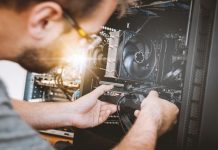
Successfully experimented in an Italian factory of washing machines the technological platform of the Grace system, a European project for the advanced production automation in which Italian enterprises and Universities took part together with European partners.
Roberto Papeschi

The European Grace project, which was targeted to the development of a smart, distributed and modular system for the manufacturing production control, represents an important stage in the evolution of industrial automation systems, for the management of manufacturing processes. In some respects, Grace can even be considered as the most important evolutionary step of the factory automation since when, in 1945, the American engineer Eugene Merchant defined CIM – Computer Integrated Manufacturing as a new management modality of all the activities that contribute in the productive process and that can be mutually integrated thanks to the presence of a computerized system. Grace – inteGration of pRocess and quAlity Control using multiAgent technology, is a Manufacturing Intelligence project developed on the base of a computerization integration system for factories, which operationally ranks just under the ERP system, between MES (Manufacturing Execution System) and DCS (Distributed Control System) levels. The main target of Grace consists in enabling the sharing and interaction of the critical information concerning the areas of the productive process and of the quality control, in order to customize the single product, to improve the process flexibility and the resource management, to reduce manufacturing costs and to allow a higher final quality of production. To achieve this target they have studied, developed and finally implemented, in a real factory, a collaborative technological solution called Multi Agent System (MAS), which operates in distributed and interactive manner on all the elements of a production line. At the end of its development this solution, characterized by innovative functions of self –adaptation and self-teaching, as well as of support to decisional strategies, was installed in Naples in a factory of washing machines made available by Whirlpool Europe, one of the partners of the project. Today it constitutes the biggest implementation in the world of multi-agent systems in production line.
The project organization
The research project EU FP7 – Grace, co-financed by the European Commission in the Seventh Framework Programme, in the ambit of the theme “Nanosciences, Nanotechnologies, Materials and New Production Technologies”, has involved a Research Centre, two Universities and three industrial partners with specific experiences in industrial automation and mechatronics, control systems, multi-agent systems, measuring and signal processing technologies for the quality control. Operationally, the project has been developed by an international research Group, of which the coordinator was Prof. Nicola Paone of the Department of Industrial Engineering and Mathematical Sciences of the Polytechnic University of Marche, while the engineer Cristina Cristalli, of the Research and Innovation team of Loccioni Group, was the technical/scientific manager. The final meeting for the project review was held in Naples on June 13th and 14th 2013; all public documents, concerning the development of Grace, are available on the web site: http://grace-project.org. In the course of the final meeting in Naples it was also possible to observe, in a real industrial environment, the functioning of the multi-agent technology, surveying the improvements of the process performances that it was possible to achieve with this technology. It is also worth noticing that, even if the Grace project has been developed on the basis of a specific productive environment, like the household appliance industry’s, the characteristics of the solution implemented in the Whirlpool factory in Naples allow its use also in other sectors of the manufacturing industry, both in existing production lines with a minimum impact on the management of standard working activities, and for the implementation of new plants.

The partners of Grace
The Consortium, which in three years of work has developed the EU FP7 – Grace research project, benefitting from a Community fund that amounts to 2.6 million Euros, was composed by the following bodies and enterprises:
– Polytechnic University of Marche – Department of Industrial Engineering and Mathematical Sciences in Ancona (Italy)
– Sintef – Research Institute with headquarters at Trondheim and Oslo (Norway)
– Polytechnic Institute at Braganca (Portugal)
– Loccioni Group (Italy)
– Whirlpool Europe (Italy)
– Siemens AG (Germany)
The project coordination was entrusted to the Polytechnic University of Marche, which has exploited its experience in contactless and adaptive measuring systems, operating in strict contact with the Polytechnic Institute in Braganca and with Sintef, responsible for the development of the MAS architecture and of local and global process controls, while the technical-scientific responsibility for the whole project was taken by Loccioni Group, world leader company in the design and implementation of automation, testing and production control solutions. Concerning the other industrial partners, Whirlpool Europe has made available its competence as big household appliance manufacturer for the Consortium, permitting also the solution testing in one of its factories. Siemens AG, in its turn, has worked at the methods and the engineering of the developed concepts, with the expertise and the activities of its Department of Project Engineering, which operates in the ambit of the Siemens Corporate Technology structure.
The Mas – Multi Agent System platform
Mas Systems, or multi agent systems, are systems constituted by a plurality of smart elements (agents), which may be data-bases and computerized sub-systems, PLC, robots, measuring stations or smart control devices, at least partially autonomous but mutually interacting through an opportune organization. Due to its characteristics, the Mas architecture is particularly suitable for being used with innovative engineering modalities in distributed intelligence manufacturing processes, permitting cutting-edge functions of self-adaptation and self-teaching depending on the information exchanged among the different elements that contribute in forming a production line. These same characteristics have been emphasized in the development of the Grace solution intended for the management of a production line for washing machines in the Whirlpool factory in Naples, where initially existed the traditional systems of process control and of quality control of stand-alone type products, not communicating one another. Through the developments of the Grace project it was on the contrary implemented the full integration of about 1500 agents, simultaneous and mutually interacting, which covered all the aspects of Process Control and Quality Control of the production line. The Mas system itself has also provided for the access to the factory Data Base from which to draw the product characteristics, to be used for the global production optimization, for the construction of the product history and the formulation of corrective strategies in the short, medium and long term. The results obtained during the testing of the Grace solution in the factory of Naples, under real production running conditions, have confirmed the validity of an approach that can be successfully adopted in several areas of the manufacturing production. Starting from the integration attained by Grace between Process Control and Quality Control systems, it is in fact possible to use the MAS multi-agent technology to integrate also other “smart” elements of the factory into a single computerized systems, ranging from those carrying out the internal handling of materials and products to those featuring a higher computerization level of production scheduling and programming (ERP system).

Technologies for the quality control
In the development of the Grace solution, utmost attention was paid by the researchers to Quality Control aspects with the use of exclusive technologies (QCA – Quality Control Agent) distributed along the whole production line. Among these technologies, considering the attained results, very relevant are the artificial vision systems for the control of the machining operations of the tank and of the drum of the washing machine, as well as for the checks of the different components assembled along the line, the measuring of the parameters regarding the water flows and the vibrations developed by the washing machine during the final testing of products. As far as machining operations are concerned, very interesting are the controls executed on the screwing operations for the assembly of the various parts of the drum and in the assembly phase of the related bearing. Controls that provide for the measuring of the depth of insertion of the bearing and of the screws, as well as of the force applied by the equipment used at controlled speed. As innovative is the system of “catadioptric” vision, for the in-line inspection of the drum geometry and its correct assembly in the washing machine tank. This system, developed by the Polytechnic University of Marche and by Loccioni Group, is based on the use of a conical mirror for the dimensional measuring of the positioning and axial alignment tolerances of the drum itself with regard to the tank. The correct assembly of the single parts on the product and of the washing machine in its entirety is detected by means of optical methods, by using self-adaptive vision robots. These vision robots allow improving the image analysis and a more precise non-conformity diagnosis, also thanks to a particular illuminator controlled in terms of colour and intensity to compensate for the different lighting conditions of the productive environment. During the inspection cycle, it is programmed that the vision robot positions itself next to a fixed number of points, previously selected, determining also the optimal exposure time for each point. The sequence of control points can be modified according to the type of product and the particular operation conditions of the production line, while the robot trajectory has been optimized by means of particular “genetic algorithms”. The robot shows adaptive behaviours when vision problems arise because of a variation of position or shape of machine parts; once detected the inability of framing the scene from the fixed position, the robot automatically searches for a new position from which to acquire a suitable image for carrying out the requested diagnosis. Finally, at the end of the assembly operations of the washing machine and in the final phase of the functional product testing, immediately before the packaging operations, they have provided for a measuring system of vibrations that uses a self-adaptive LDV – Laser Doppler Vibrometer device. Also the performances of this system, like those of the other stations for the quality control of the production line, are optimized thanks to the use of self-adapting and reconfigurability methodologies, made possible by the multi-agent structure of the MAS platform. In particular, the system developed by the Polytechnic University of Marche provides for the self-adaptation of the LDV system with the automatic research on the washing machine of “target” points for the measuring of vibrations, also in the case of an incorrect product positioning as well as in the automatic prearrangement of the optimal conditions for the Doppler signal reception.

Result integration
The approach to the Mas system, followed by the partners of Grace, has provided for the creation of a society of autonomous and collaborative “agents”, arranged along the whole production line and able to represent the elements of the manufacturing process smartly. Such agents have been classified in the following categories:
– PTA- Product Type Agents (for the representation of the product catalogue)
– PA- Product Agents (they manage the specific machining requirements along the line)
– RA- Resource Agents (they represent the physical resources of which the line makes use)
– IMA- Independent Meta Agents (for the implementation of supervision, planning and decision-making mechanisms)
Each of these agents of the Mas system, distributed along the production line and autonomous in their specific functions, owns just local knowledge of the productive situation. To obtain the global optimization of the process and quality control system, as pursued by the targets of the Grace project, it was then compulsory the integration of information, deducted in real time by each agent during machining operations and line controls, besides the access to the factory Data Base from which to obtain the characteristics and the data of each product and of the different phases of the production process. Concerning this, the data acquired by MA (Machine Agent) and QCA (Quality Control Agent) agents were particularly relevant, since from their processing were then drawn both local and global indexes, which in their turn are transmitted to the factory Data Base and afterwards stored in the Quality System. It is also worth noticing that, in this processing, the IMA agents, that’s to say Independent Meta Agents, are involved to achieve correlations and statistical analyses already in the course of the first production phases, able to detect the trends of the productive process and to start timely the opportune corrective actions.


Achieved results
The results achieved through the implementation of the Grace system into the production line for washing machines of the Whirlpool factory in Naples were discussed on the occasion of the conclusive meeting of the project team on June 13th and 14th 2013 and are summarized as follows:
– Productive customization of each product, thanks to the abilities of the MAS system of adapting, in interactive way, the machining and control modalities of the line to each specific production situation.
– Effective supervision of the product quality, extended not only to the final phases of the production process but immediately to each intermediate machining step.
– General improvement of the product quality thanks to a productive process oriented to the global optimization starting from the detection of the current process quality.
– Improvement of the productive efficiency, thanks to the capability of processing specific product quality problems, consequently adapting test programmes, in order to reduce control and testing times of products.
– Reduction of production costs as a consequence of the fact that the product quality can be assessed at any time, with the prompt elimination of defects already in the intermediate machining phases. The full quality control, on each process phase and on 100% of products, reduces the quantity of products undergoing the final testing and eliminates the need of additional controls in the factory.
– During the validation phase of the project results, global improvements were surveyed, consisting in a significant decrease of plant downtimes and in an essential improvement of product performances, together with the following measured results:
– Reduction of the non-compliance of products: 1.5%
– Reduction of functional test times: 20%





